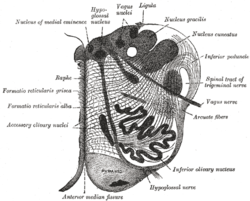- Dorsal respiratory group
-
Brain: Dorsal respiratory group 
Section of the medulla oblongata at about the middle of the olive. (Dorsal respiratory group not labeled, but spinal tract labeled at center right.) The dorsal respiratory group (DRG) is located in the dorsomedial region of the medulla, and is composed of cells in the solitary tract nucleus. The DRG is one of two known respiratory neuron localizations, with the other being the ventral respiratory group. The DRG is found in many types of fish and mammals. [1]
Contents
Respiratory effects
The DRG is involved in the generation of respiratory rhythm, and is primarily responsible for the generation of inspiration. It is stimulated via the apneustic center in the lower pons and is also a part of the solitary tract, which is responsible for appropriating responses to sensory information from chemoreceptors and mechanoreceptors in humans.
Inspiration begins when cells of the solitary tract nucleus (along with cells of the ventral respiratory group) begin a steady increase in firing, leading to contraction of the respiratory muscles. When neurons in the DRG fire, impulses travel down the phrenic and intercostal nerves to stimulate the diaphragm and external intercostal muscles. The thoracic cavity expands and air rushes into the lungs due to the negative pressure, producing inspiration. When the cells stop firing, the inspiratory muscles relax, inspiration ceases, and exhalation begins.
The rhythm of the DRG produces a respiratory rate of 12-16 breaths per minute in humans. Inspiration usually lasts approximately 2 seconds, and expiration lasts about 3 seconds. The normal inspiration rate and rhythm is called eupnea, and difficult respiration is termed dyspnea.
See also
- Ventral respiratory group
- Pontine respiratory group
External links
References
- ^ Kolesnikova, EE (2011). "Role of glutamate and GABA in mechanisms underlying respiratory control". Neurophysiology (Bogomolets Institute of Physiology, Kiev, Ukraine) 42 (4): 294–304.
Berne, Robert M.; Levy, Matthew N.;Koeppen, Bruce M.;Stanton, Bruce A. (2004). Physiology, 5th edition. St. Louis, MO: Elsevier. pp. 513. ISBN 0-323-03390-3.
Human brain: rhombencephalon, myelencephalon: medulla (TA A14.1.04, GA 9.767) Dorsal SurfacePosterior median sulcus · Posterolateral sulcus · Area postrema · Vagal trigone · Hypoglossal trigone · Medial eminenceafferent: GVA: VII,IX,X: Solitary/tract/Dorsal respiratory group · SVA: Gustatory nucleus · GSA: VIII-v (Lateral, Medial, Inferior)
efferent: GSE: XII · GVE: IX,X,XI: Ambiguus · SVE: X: Dorsal · IX: Inferior salivatory nucleusVentral Ventral respiratory group · Arcuate nucleus of medulla · Inferior olivary nucleus · Rostral ventromedial medullaSurfaceGrey: Raphe/
reticularCategories:- Neuroanatomy
- Neuroscience stubs
- Respiratory system stubs
Wikimedia Foundation. 2010.
